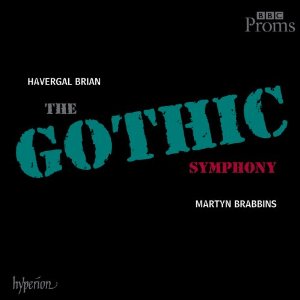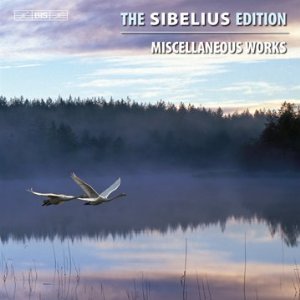 Havergal Brian: Symphony No 1 The Gothic BBC National Orchestra of Wales, BBC Concert Orchestra etc/Martyn Brabbins (Hyperion)
Havergal Brian: Symphony No 1 The Gothic BBC National Orchestra of Wales, BBC Concert Orchestra etc/Martyn Brabbins (Hyperion)
The performers involved are too numerous to list above; Hyperion do include the names of every instrumentalist, soloist and choir member in the booklet, more than 800 of them. This is a recording of the 2011 Proms performance, recorded with spectacular definition by the BBC on 17 July last year. Where to begin? This is a hugely impressive record of a great performance, but I’m not convinced that this is great music. But you can’t help feeling thankful that once in a generation we’re given the chance to hear something of this magnitude and judge the results for ourselves. Havergal Brian wrote the work between 1919 and 1927. Superficially it’s pretty cosmopolitan; you can hear hints of Elgar, Strauss and early, tonal Schoenberg. Mahler 8 comes to mind too, as does Berlioz’s Grande messe des morts. There’s real skill in the handling of some of the climaxes, and enough moments of quirky invention to satisfy devotees of eccentric orchestration – my favourite being the insane xylophone solo near the end of the purely instrumental Part One.
But, sadly, so little of the thematic material is genuinely memorable, and Brian’s sense of structure isn’t as assured as that of his late-Romantic contemporaries. At times it’s as if we’re flicking abruptly between a series of unrelated items; medieval plainchant to beefy tuba parping to florid tenor solo. I’d have loved to have heard the symphony in the flesh, especially for the quiet choral close, but I’m not sure how often I’ll return to these discs. Hyperion's sleeve art is fun, but after several listens I needed an extended lie down accompanied by a Bach cello suite.
 Shostakovich: Cello Concertos Enrico Dindo (cello), Danish National Symphony Orchestra/Gianandrea Noseda (Chandos)
Shostakovich: Cello Concertos Enrico Dindo (cello), Danish National Symphony Orchestra/Gianandrea Noseda (Chandos)
Skip to track four, and Shostakovich’s lesser-known Cello Concerto No 2, composed like No 1 for Mstislav Rostropovich. Premiered in 1966, it’s one of the most elegiac, gloomy things that this famously downbeat composer produced. Predominantly slow-moving, there’s little of the aggressive affirmation of the earlier concerto here, but the music offers plenty of scope for a decent interpreter to make the music sing, even finding hints of Romanticism and wry humour. There’s a dark magic in the way that the Italian cellist Enrico Dindo unfolds his opening monologue, matched by Gianandrea Noseda’s careful colouring of the muted first orchestral entry. The central Scherzo, based on an Odessa folk song, features some fabulous orchestral bassoon playing, but it’s the finale which really haunts. Here the material is wistful, bittersweet, building to a terrifying climax, which leads to a slow disintegration, the ticking percussion suggesting a life ebbing away. Terrific, and Dindo’s bravura approach gives this elusive piece much more presence than usual, helped by Noseda’s brilliant solo winds.
The brasher, more pungent Concerto No 1 is edge-of-the-seat stuff; the faster outer movements painted in lurid primary colours, dominated by a larger-than-life solo horn. And Shostakovich’s rhythmic subtlety, not generally seen as his greatest asset, is stressed more than usual, with the last movement’s metrical shifts negotiated with verve. Spacious recorded sound makes this a refreshing, vivid listen, and David Fanning’s sleeve notes are fascinating.
 The Sibelius Edition Volume 13: Miscellaneous Works Various Artists (BIS)
The Sibelius Edition Volume 13: Miscellaneous Works Various Artists (BIS)
The final instalment in the Swedish label BIS’s Sibelius survey mops up the odds and ends. There’s an incredible range of material strewn across the four discs in this set. Much of it is superb, but this most self-critical of composers didn’t always operate at white heat. Sibelius buffs will head immediately for two late organ pieces. The 1925 Intrada commemorates a Swedish royal visit, and 1931's Surusoitto (Funeral Music) was long thought to contain material originally destined for the lost Symphony No 8. Surosoitto is peculiar, unsettling music; the harmonies bolder, starker than we’re used to. The manuscript for the symphony probably ended up in a bonfire, but Sibelius didn’t abandon composition in the last years of his life. Two movements from the extended collection of Masonic Ritual Music date from 1946 and are possibly the last original pieces Sibelius composed. Sadly, neither is as ear-catching as Surusoitto. We get a preliminary version of the opening paragraph of Pohloja’s Daughter, which suddenly segues into material used in Symphony No 3. Fascinating, but the revised version works so much better.
We can hear 21 tiny unpublished Piano Works for Children from 1899, several containing motifs reused in better-known published pieces. Sibelius biographer Andrew Barnett gives us glockenspiel renditions of material arranged for the chimes of a Helsinki church, and we get to hear the actual bell sounds play what Sibelius eventually chose. There’s an uneven disc of music composed by friends and contemporaries, and the 1939 recording of Sibelius conducting his Andante festivo along with rare silent film footage of the composer. There’s also a DVD entitled Visual Journey to the Music of Jean Sibelius, a greatest-hits playlist accompanied by Janne Gröning’s exquisite photographs. All immaculately presented, performed and produced. An essential purchase.
Watch 1945 film footage of Jean Sibelius














Add comment